Healthcare Finance: Australia, UK, US - A Comparative Analysis
VerifiedAdded on 2022/12/18
|10
|2397
|1
Report
AI Summary
This report undertakes a comparative analysis of the financial structures of healthcare systems in Australia, the United Kingdom, and the United States. It examines the roles of government, public, and private insurance, providing a detailed comparison of funding models and financial implications. The report delves into performance measures, including GDP spending on healthcare and annual growth rates, to assess the effectiveness of each system. Furthermore, it identifies financial challenges faced by each country, such as economic constraints in Australia, rising technology and medicine costs in the UK, and legislative changes in the US. The report concludes with recommendations for addressing social and financial implications, aiming to improve healthcare service delivery and financial sustainability. This assignment, contributed by a student, is available on Desklib, a platform offering AI-driven study tools.
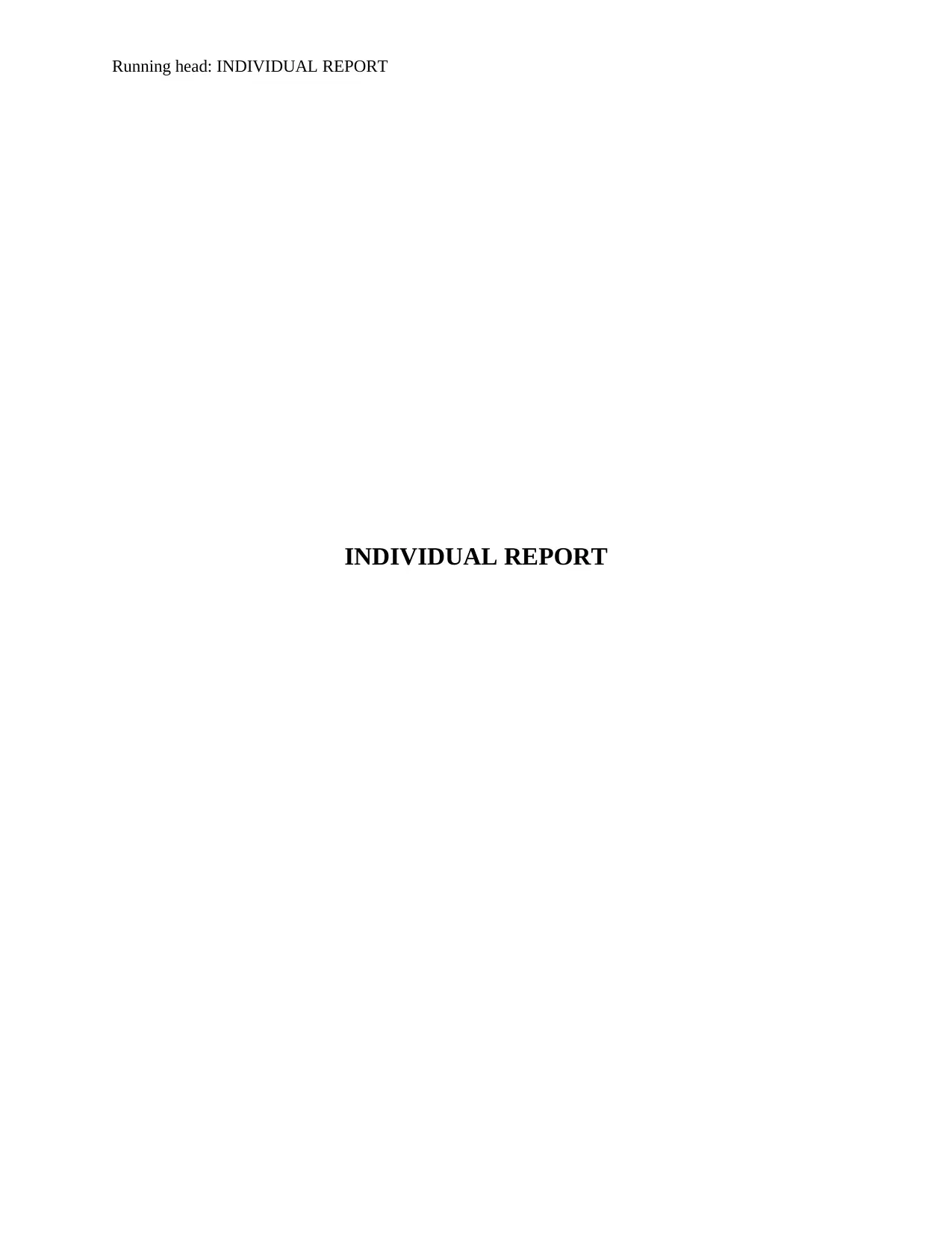
Running head: INDIVIDUAL REPORT
INDIVIDUAL REPORT
INDIVIDUAL REPORT
Paraphrase This Document
Need a fresh take? Get an instant paraphrase of this document with our AI Paraphraser
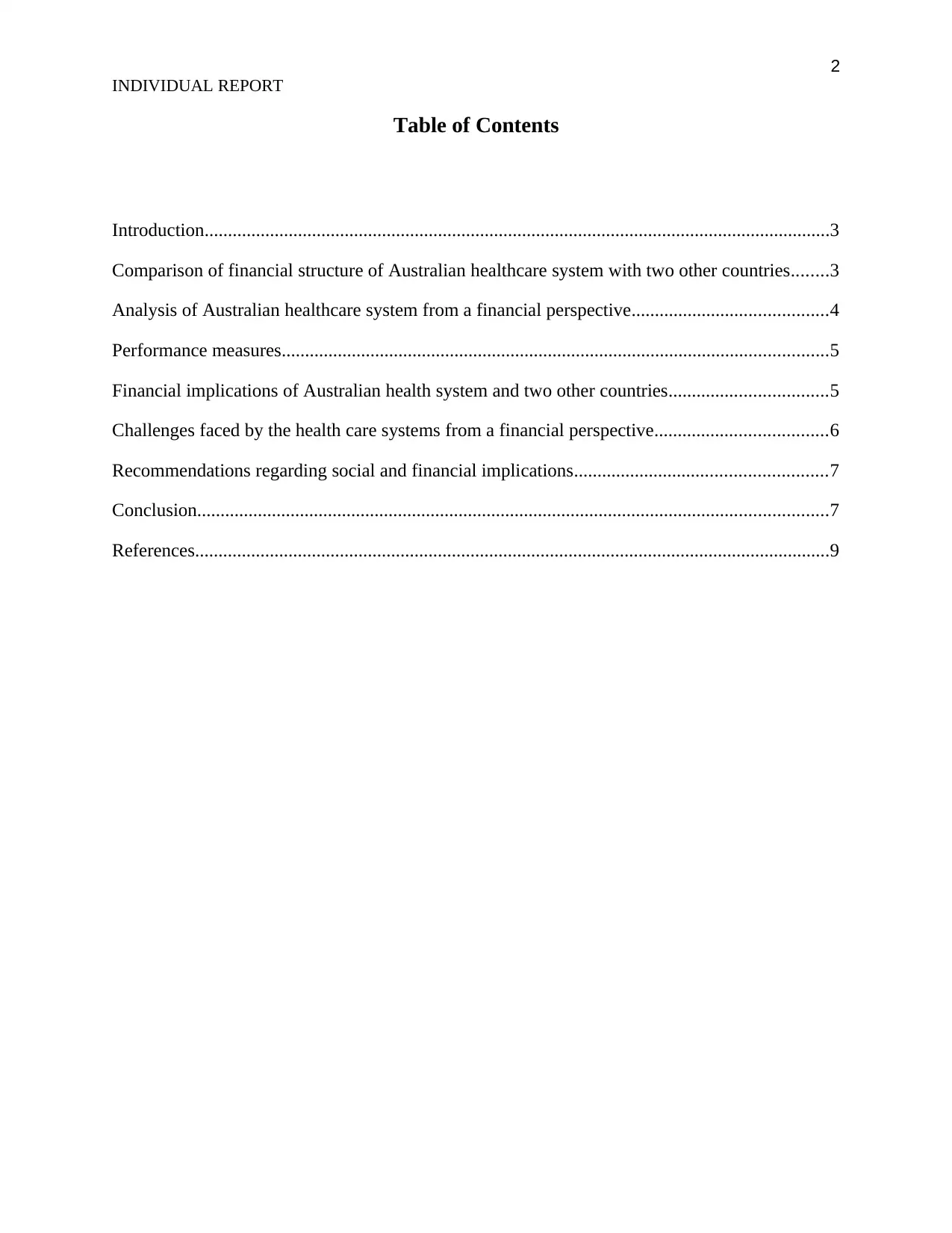
2
INDIVIDUAL REPORT
Table of Contents
Introduction......................................................................................................................................3
Comparison of financial structure of Australian healthcare system with two other countries........3
Analysis of Australian healthcare system from a financial perspective..........................................4
Performance measures.....................................................................................................................5
Financial implications of Australian health system and two other countries..................................5
Challenges faced by the health care systems from a financial perspective.....................................6
Recommendations regarding social and financial implications......................................................7
Conclusion.......................................................................................................................................7
References........................................................................................................................................9
INDIVIDUAL REPORT
Table of Contents
Introduction......................................................................................................................................3
Comparison of financial structure of Australian healthcare system with two other countries........3
Analysis of Australian healthcare system from a financial perspective..........................................4
Performance measures.....................................................................................................................5
Financial implications of Australian health system and two other countries..................................5
Challenges faced by the health care systems from a financial perspective.....................................6
Recommendations regarding social and financial implications......................................................7
Conclusion.......................................................................................................................................7
References........................................................................................................................................9
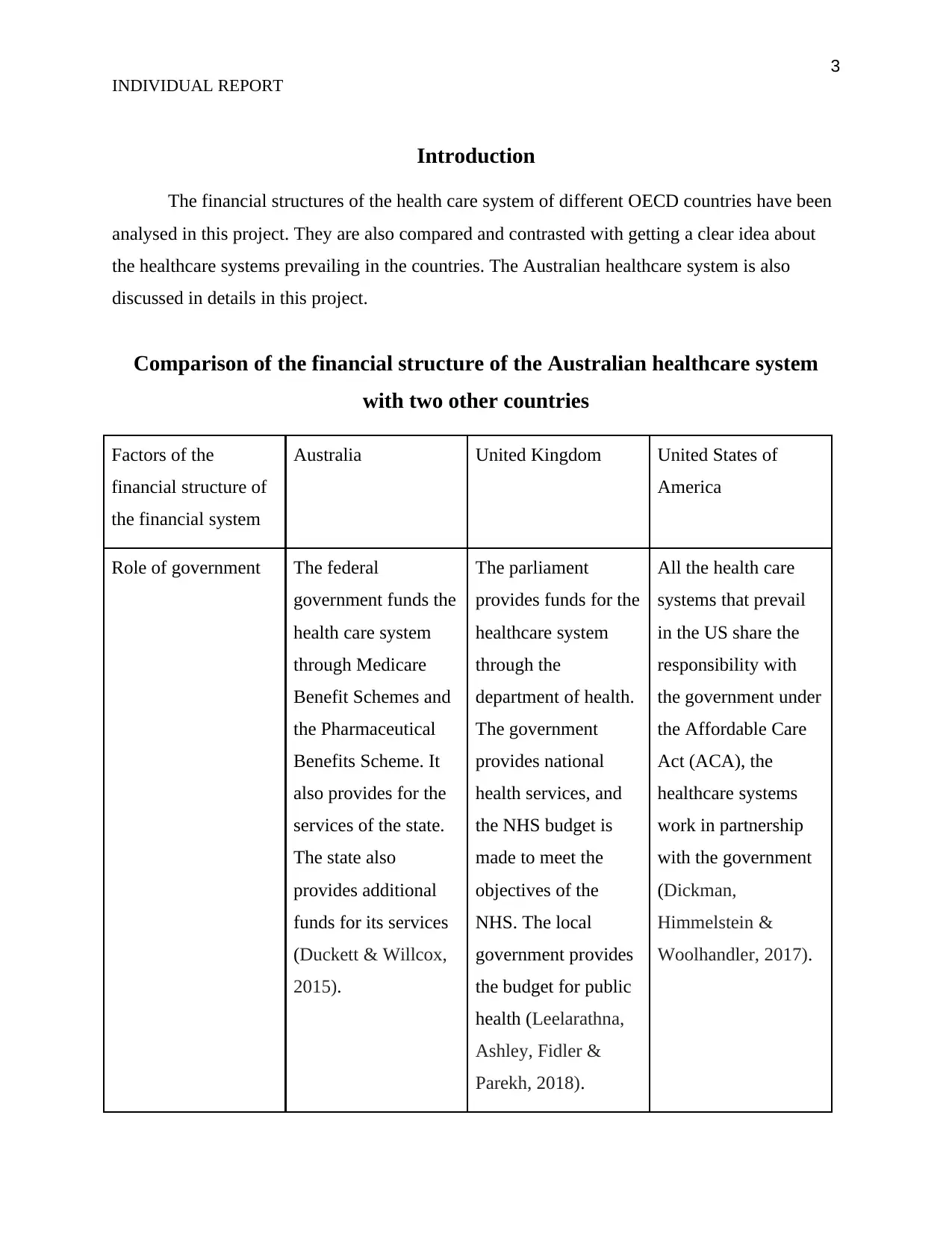
3
INDIVIDUAL REPORT
Introduction
The financial structures of the health care system of different OECD countries have been
analysed in this project. They are also compared and contrasted with getting a clear idea about
the healthcare systems prevailing in the countries. The Australian healthcare system is also
discussed in details in this project.
Comparison of the financial structure of the Australian healthcare system
with two other countries
Factors of the
financial structure of
the financial system
Australia United Kingdom United States of
America
Role of government The federal
government funds the
health care system
through Medicare
Benefit Schemes and
the Pharmaceutical
Benefits Scheme. It
also provides for the
services of the state.
The state also
provides additional
funds for its services
(Duckett & Willcox,
2015).
The parliament
provides funds for the
healthcare system
through the
department of health.
The government
provides national
health services, and
the NHS budget is
made to meet the
objectives of the
NHS. The local
government provides
the budget for public
health (Leelarathna,
Ashley, Fidler &
Parekh, 2018).
All the health care
systems that prevail
in the US share the
responsibility with
the government under
the Affordable Care
Act (ACA), the
healthcare systems
work in partnership
with the government
(Dickman,
Himmelstein &
Woolhandler, 2017).
INDIVIDUAL REPORT
Introduction
The financial structures of the health care system of different OECD countries have been
analysed in this project. They are also compared and contrasted with getting a clear idea about
the healthcare systems prevailing in the countries. The Australian healthcare system is also
discussed in details in this project.
Comparison of the financial structure of the Australian healthcare system
with two other countries
Factors of the
financial structure of
the financial system
Australia United Kingdom United States of
America
Role of government The federal
government funds the
health care system
through Medicare
Benefit Schemes and
the Pharmaceutical
Benefits Scheme. It
also provides for the
services of the state.
The state also
provides additional
funds for its services
(Duckett & Willcox,
2015).
The parliament
provides funds for the
healthcare system
through the
department of health.
The government
provides national
health services, and
the NHS budget is
made to meet the
objectives of the
NHS. The local
government provides
the budget for public
health (Leelarathna,
Ashley, Fidler &
Parekh, 2018).
All the health care
systems that prevail
in the US share the
responsibility with
the government under
the Affordable Care
Act (ACA), the
healthcare systems
work in partnership
with the government
(Dickman,
Himmelstein &
Woolhandler, 2017).
⊘ This is a preview!⊘
Do you want full access?
Subscribe today to unlock all pages.

Trusted by 1+ million students worldwide
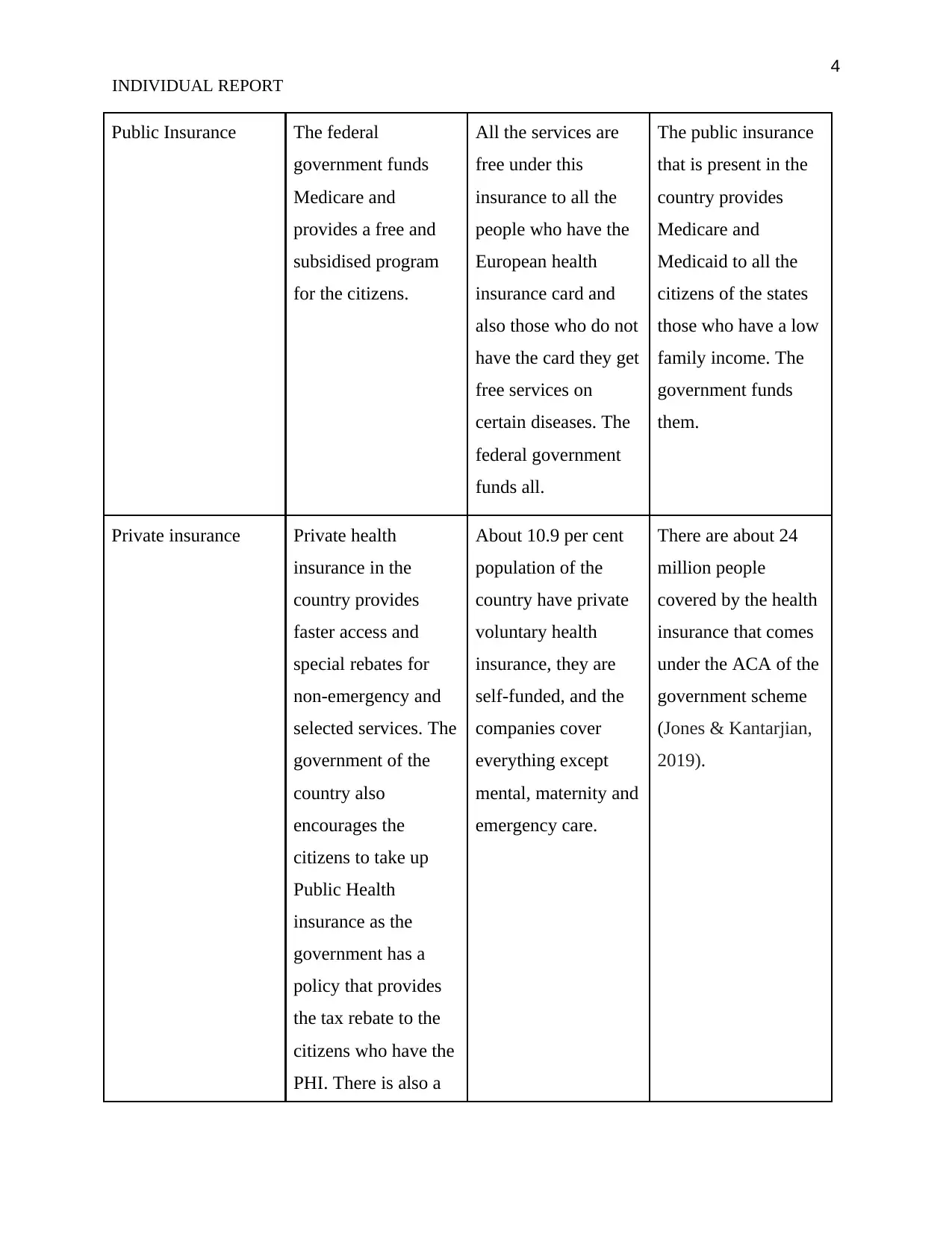
4
INDIVIDUAL REPORT
Public Insurance The federal
government funds
Medicare and
provides a free and
subsidised program
for the citizens.
All the services are
free under this
insurance to all the
people who have the
European health
insurance card and
also those who do not
have the card they get
free services on
certain diseases. The
federal government
funds all.
The public insurance
that is present in the
country provides
Medicare and
Medicaid to all the
citizens of the states
those who have a low
family income. The
government funds
them.
Private insurance Private health
insurance in the
country provides
faster access and
special rebates for
non-emergency and
selected services. The
government of the
country also
encourages the
citizens to take up
Public Health
insurance as the
government has a
policy that provides
the tax rebate to the
citizens who have the
PHI. There is also a
About 10.9 per cent
population of the
country have private
voluntary health
insurance, they are
self-funded, and the
companies cover
everything except
mental, maternity and
emergency care.
There are about 24
million people
covered by the health
insurance that comes
under the ACA of the
government scheme
(Jones & Kantarjian,
2019).
INDIVIDUAL REPORT
Public Insurance The federal
government funds
Medicare and
provides a free and
subsidised program
for the citizens.
All the services are
free under this
insurance to all the
people who have the
European health
insurance card and
also those who do not
have the card they get
free services on
certain diseases. The
federal government
funds all.
The public insurance
that is present in the
country provides
Medicare and
Medicaid to all the
citizens of the states
those who have a low
family income. The
government funds
them.
Private insurance Private health
insurance in the
country provides
faster access and
special rebates for
non-emergency and
selected services. The
government of the
country also
encourages the
citizens to take up
Public Health
insurance as the
government has a
policy that provides
the tax rebate to the
citizens who have the
PHI. There is also a
About 10.9 per cent
population of the
country have private
voluntary health
insurance, they are
self-funded, and the
companies cover
everything except
mental, maternity and
emergency care.
There are about 24
million people
covered by the health
insurance that comes
under the ACA of the
government scheme
(Jones & Kantarjian,
2019).
Paraphrase This Document
Need a fresh take? Get an instant paraphrase of this document with our AI Paraphraser
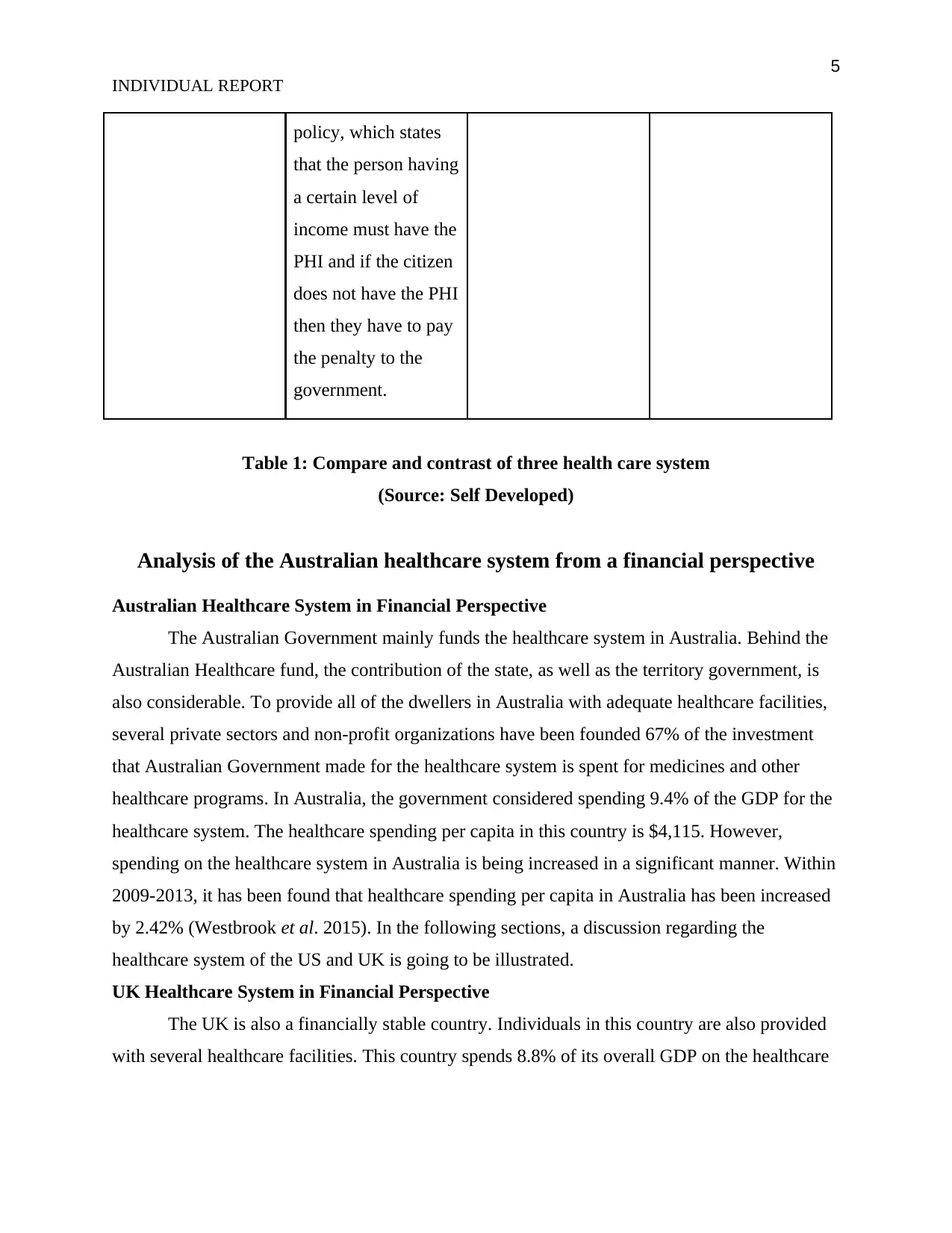
5
INDIVIDUAL REPORT
policy, which states
that the person having
a certain level of
income must have the
PHI and if the citizen
does not have the PHI
then they have to pay
the penalty to the
government.
Table 1: Compare and contrast of three health care system
(Source: Self Developed)
Analysis of the Australian healthcare system from a financial perspective
Australian Healthcare System in Financial Perspective
The Australian Government mainly funds the healthcare system in Australia. Behind the
Australian Healthcare fund, the contribution of the state, as well as the territory government, is
also considerable. To provide all of the dwellers in Australia with adequate healthcare facilities,
several private sectors and non-profit organizations have been founded 67% of the investment
that Australian Government made for the healthcare system is spent for medicines and other
healthcare programs. In Australia, the government considered spending 9.4% of the GDP for the
healthcare system. The healthcare spending per capita in this country is $4,115. However,
spending on the healthcare system in Australia is being increased in a significant manner. Within
2009-2013, it has been found that healthcare spending per capita in Australia has been increased
by 2.42% (Westbrook et al. 2015). In the following sections, a discussion regarding the
healthcare system of the US and UK is going to be illustrated.
UK Healthcare System in Financial Perspective
The UK is also a financially stable country. Individuals in this country are also provided
with several healthcare facilities. This country spends 8.8% of its overall GDP on the healthcare
INDIVIDUAL REPORT
policy, which states
that the person having
a certain level of
income must have the
PHI and if the citizen
does not have the PHI
then they have to pay
the penalty to the
government.
Table 1: Compare and contrast of three health care system
(Source: Self Developed)
Analysis of the Australian healthcare system from a financial perspective
Australian Healthcare System in Financial Perspective
The Australian Government mainly funds the healthcare system in Australia. Behind the
Australian Healthcare fund, the contribution of the state, as well as the territory government, is
also considerable. To provide all of the dwellers in Australia with adequate healthcare facilities,
several private sectors and non-profit organizations have been founded 67% of the investment
that Australian Government made for the healthcare system is spent for medicines and other
healthcare programs. In Australia, the government considered spending 9.4% of the GDP for the
healthcare system. The healthcare spending per capita in this country is $4,115. However,
spending on the healthcare system in Australia is being increased in a significant manner. Within
2009-2013, it has been found that healthcare spending per capita in Australia has been increased
by 2.42% (Westbrook et al. 2015). In the following sections, a discussion regarding the
healthcare system of the US and UK is going to be illustrated.
UK Healthcare System in Financial Perspective
The UK is also a financially stable country. Individuals in this country are also provided
with several healthcare facilities. This country spends 8.8% of its overall GDP on the healthcare
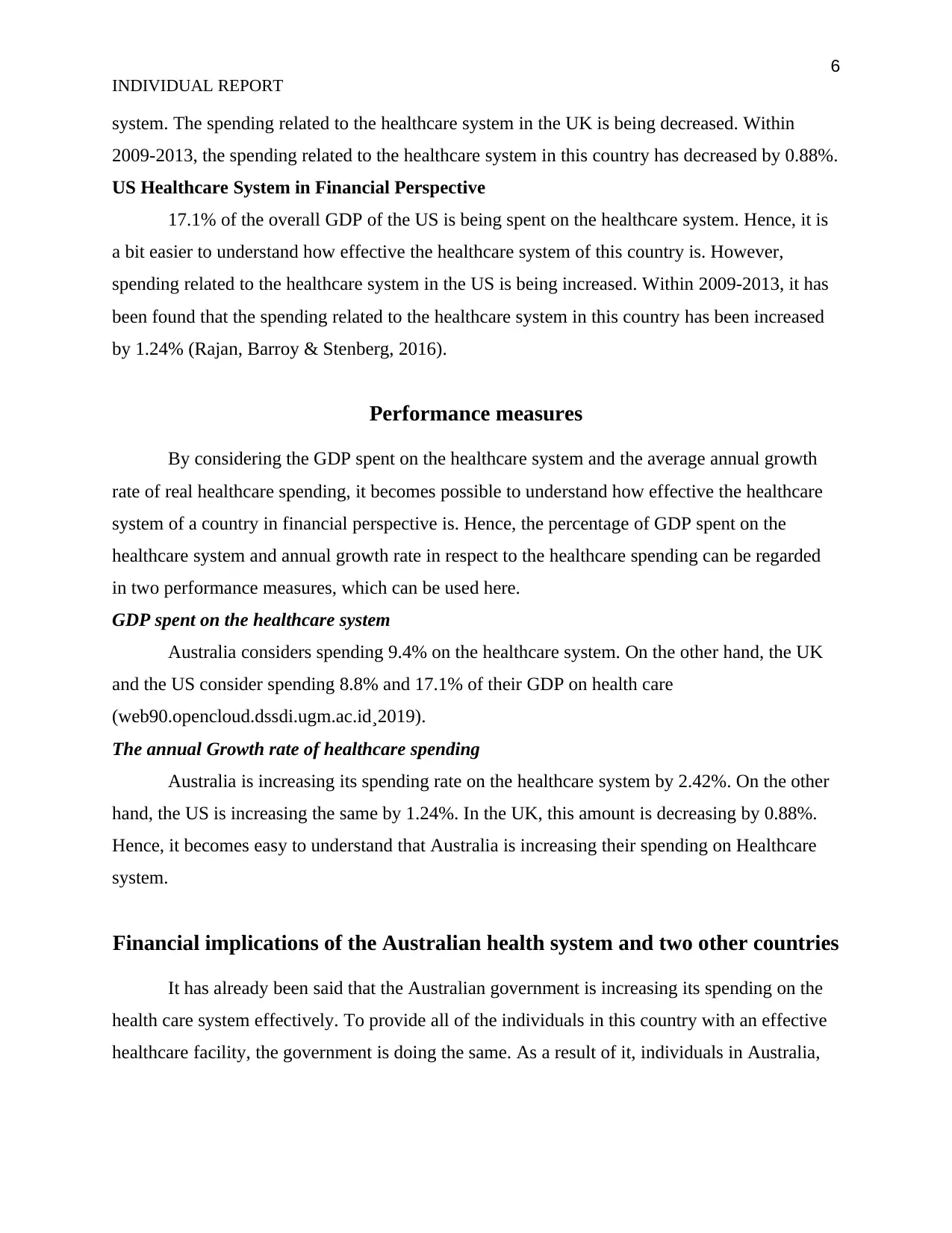
6
INDIVIDUAL REPORT
system. The spending related to the healthcare system in the UK is being decreased. Within
2009-2013, the spending related to the healthcare system in this country has decreased by 0.88%.
US Healthcare System in Financial Perspective
17.1% of the overall GDP of the US is being spent on the healthcare system. Hence, it is
a bit easier to understand how effective the healthcare system of this country is. However,
spending related to the healthcare system in the US is being increased. Within 2009-2013, it has
been found that the spending related to the healthcare system in this country has been increased
by 1.24% (Rajan, Barroy & Stenberg, 2016).
Performance measures
By considering the GDP spent on the healthcare system and the average annual growth
rate of real healthcare spending, it becomes possible to understand how effective the healthcare
system of a country in financial perspective is. Hence, the percentage of GDP spent on the
healthcare system and annual growth rate in respect to the healthcare spending can be regarded
in two performance measures, which can be used here.
GDP spent on the healthcare system
Australia considers spending 9.4% on the healthcare system. On the other hand, the UK
and the US consider spending 8.8% and 17.1% of their GDP on health care
(web90.opencloud.dssdi.ugm.ac.id¸2019).
The annual Growth rate of healthcare spending
Australia is increasing its spending rate on the healthcare system by 2.42%. On the other
hand, the US is increasing the same by 1.24%. In the UK, this amount is decreasing by 0.88%.
Hence, it becomes easy to understand that Australia is increasing their spending on Healthcare
system.
Financial implications of the Australian health system and two other countries
It has already been said that the Australian government is increasing its spending on the
health care system effectively. To provide all of the individuals in this country with an effective
healthcare facility, the government is doing the same. As a result of it, individuals in Australia,
INDIVIDUAL REPORT
system. The spending related to the healthcare system in the UK is being decreased. Within
2009-2013, the spending related to the healthcare system in this country has decreased by 0.88%.
US Healthcare System in Financial Perspective
17.1% of the overall GDP of the US is being spent on the healthcare system. Hence, it is
a bit easier to understand how effective the healthcare system of this country is. However,
spending related to the healthcare system in the US is being increased. Within 2009-2013, it has
been found that the spending related to the healthcare system in this country has been increased
by 1.24% (Rajan, Barroy & Stenberg, 2016).
Performance measures
By considering the GDP spent on the healthcare system and the average annual growth
rate of real healthcare spending, it becomes possible to understand how effective the healthcare
system of a country in financial perspective is. Hence, the percentage of GDP spent on the
healthcare system and annual growth rate in respect to the healthcare spending can be regarded
in two performance measures, which can be used here.
GDP spent on the healthcare system
Australia considers spending 9.4% on the healthcare system. On the other hand, the UK
and the US consider spending 8.8% and 17.1% of their GDP on health care
(web90.opencloud.dssdi.ugm.ac.id¸2019).
The annual Growth rate of healthcare spending
Australia is increasing its spending rate on the healthcare system by 2.42%. On the other
hand, the US is increasing the same by 1.24%. In the UK, this amount is decreasing by 0.88%.
Hence, it becomes easy to understand that Australia is increasing their spending on Healthcare
system.
Financial implications of the Australian health system and two other countries
It has already been said that the Australian government is increasing its spending on the
health care system effectively. To provide all of the individuals in this country with an effective
healthcare facility, the government is doing the same. As a result of it, individuals in Australia,
⊘ This is a preview!⊘
Do you want full access?
Subscribe today to unlock all pages.

Trusted by 1+ million students worldwide
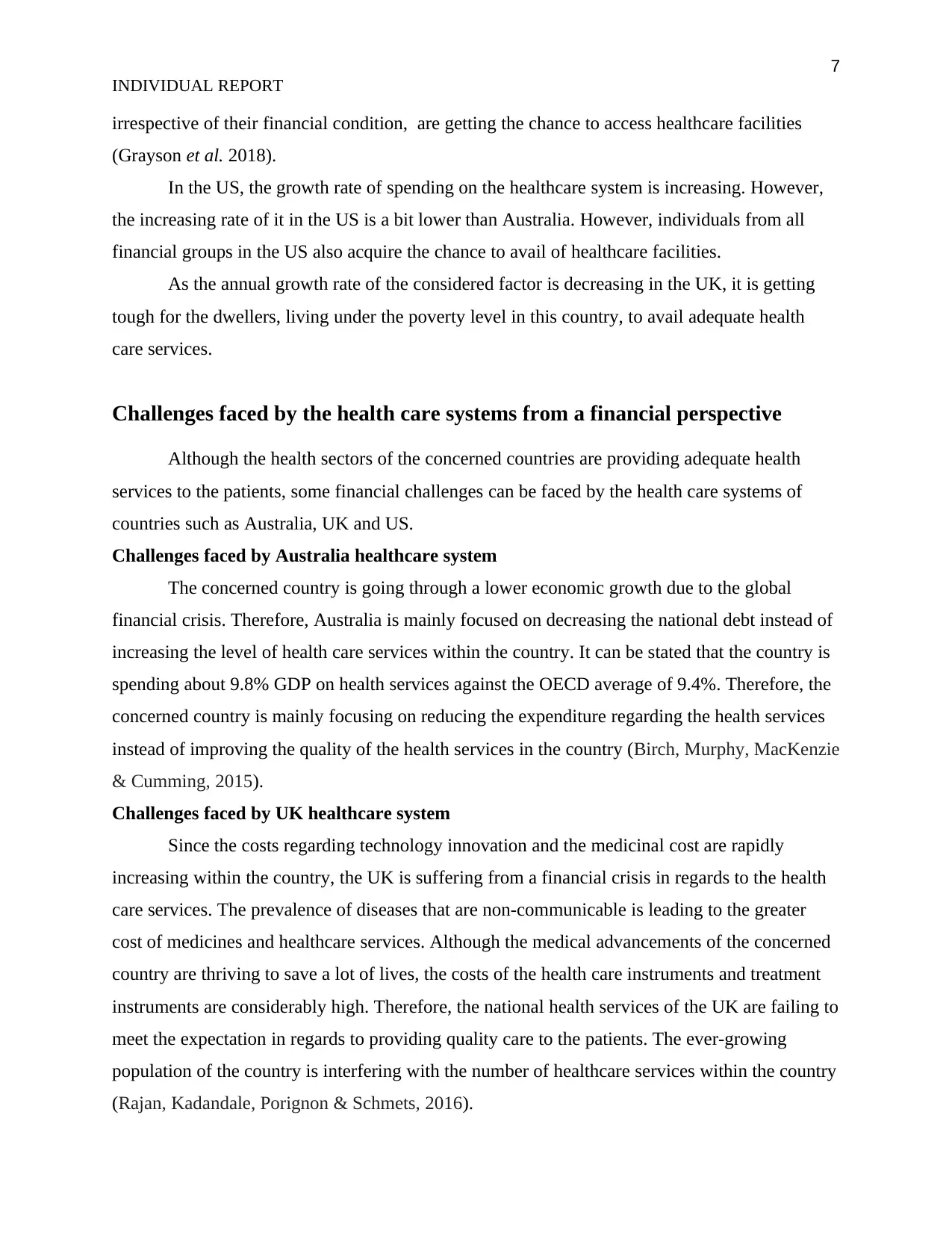
7
INDIVIDUAL REPORT
irrespective of their financial condition, are getting the chance to access healthcare facilities
(Grayson et al. 2018).
In the US, the growth rate of spending on the healthcare system is increasing. However,
the increasing rate of it in the US is a bit lower than Australia. However, individuals from all
financial groups in the US also acquire the chance to avail of healthcare facilities.
As the annual growth rate of the considered factor is decreasing in the UK, it is getting
tough for the dwellers, living under the poverty level in this country, to avail adequate health
care services.
Challenges faced by the health care systems from a financial perspective
Although the health sectors of the concerned countries are providing adequate health
services to the patients, some financial challenges can be faced by the health care systems of
countries such as Australia, UK and US.
Challenges faced by Australia healthcare system
The concerned country is going through a lower economic growth due to the global
financial crisis. Therefore, Australia is mainly focused on decreasing the national debt instead of
increasing the level of health care services within the country. It can be stated that the country is
spending about 9.8% GDP on health services against the OECD average of 9.4%. Therefore, the
concerned country is mainly focusing on reducing the expenditure regarding the health services
instead of improving the quality of the health services in the country (Birch, Murphy, MacKenzie
& Cumming, 2015).
Challenges faced by UK healthcare system
Since the costs regarding technology innovation and the medicinal cost are rapidly
increasing within the country, the UK is suffering from a financial crisis in regards to the health
care services. The prevalence of diseases that are non-communicable is leading to the greater
cost of medicines and healthcare services. Although the medical advancements of the concerned
country are thriving to save a lot of lives, the costs of the health care instruments and treatment
instruments are considerably high. Therefore, the national health services of the UK are failing to
meet the expectation in regards to providing quality care to the patients. The ever-growing
population of the country is interfering with the number of healthcare services within the country
(Rajan, Kadandale, Porignon & Schmets, 2016).
INDIVIDUAL REPORT
irrespective of their financial condition, are getting the chance to access healthcare facilities
(Grayson et al. 2018).
In the US, the growth rate of spending on the healthcare system is increasing. However,
the increasing rate of it in the US is a bit lower than Australia. However, individuals from all
financial groups in the US also acquire the chance to avail of healthcare facilities.
As the annual growth rate of the considered factor is decreasing in the UK, it is getting
tough for the dwellers, living under the poverty level in this country, to avail adequate health
care services.
Challenges faced by the health care systems from a financial perspective
Although the health sectors of the concerned countries are providing adequate health
services to the patients, some financial challenges can be faced by the health care systems of
countries such as Australia, UK and US.
Challenges faced by Australia healthcare system
The concerned country is going through a lower economic growth due to the global
financial crisis. Therefore, Australia is mainly focused on decreasing the national debt instead of
increasing the level of health care services within the country. It can be stated that the country is
spending about 9.8% GDP on health services against the OECD average of 9.4%. Therefore, the
concerned country is mainly focusing on reducing the expenditure regarding the health services
instead of improving the quality of the health services in the country (Birch, Murphy, MacKenzie
& Cumming, 2015).
Challenges faced by UK healthcare system
Since the costs regarding technology innovation and the medicinal cost are rapidly
increasing within the country, the UK is suffering from a financial crisis in regards to the health
care services. The prevalence of diseases that are non-communicable is leading to the greater
cost of medicines and healthcare services. Although the medical advancements of the concerned
country are thriving to save a lot of lives, the costs of the health care instruments and treatment
instruments are considerably high. Therefore, the national health services of the UK are failing to
meet the expectation in regards to providing quality care to the patients. The ever-growing
population of the country is interfering with the number of healthcare services within the country
(Rajan, Kadandale, Porignon & Schmets, 2016).
Paraphrase This Document
Need a fresh take? Get an instant paraphrase of this document with our AI Paraphraser
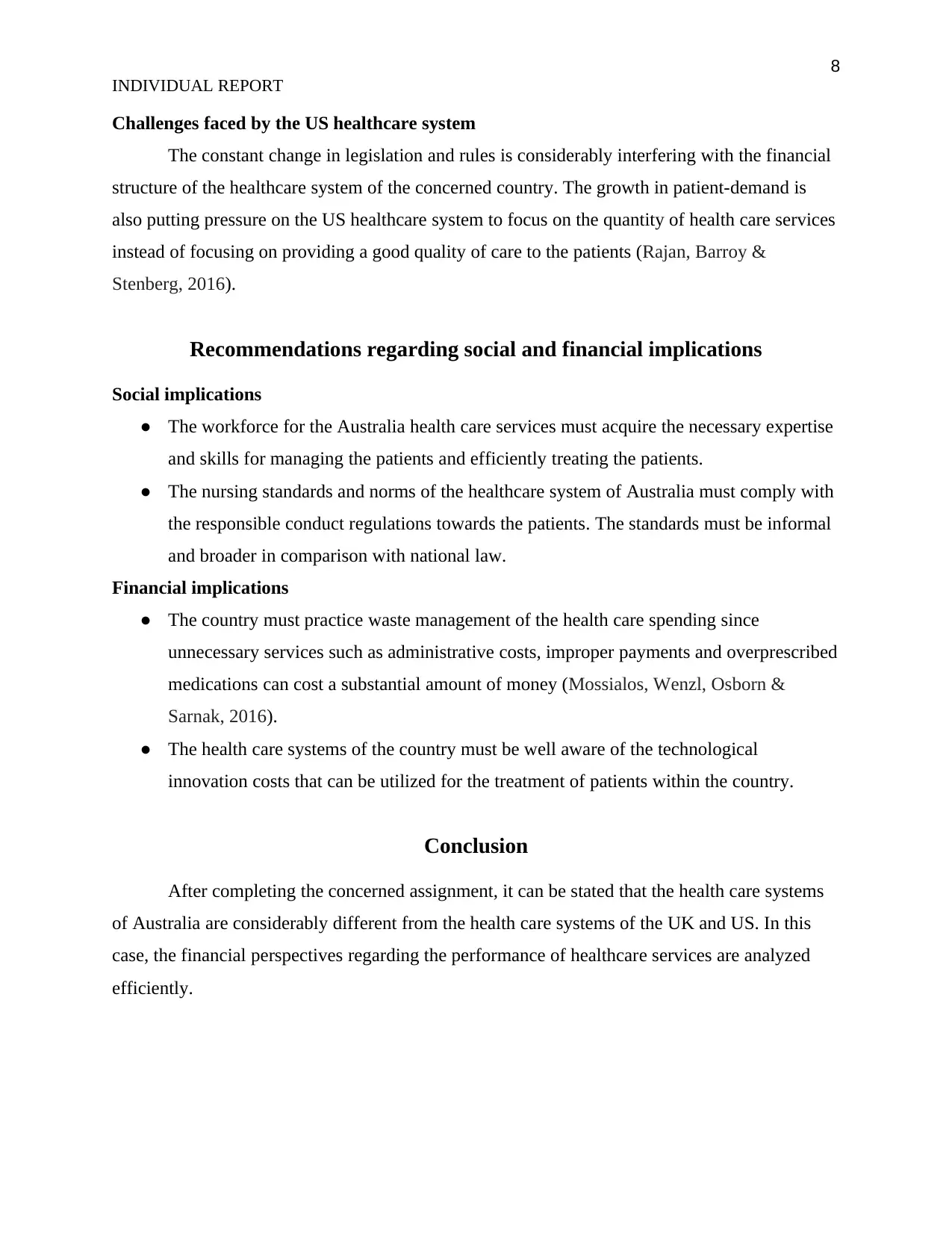
8
INDIVIDUAL REPORT
Challenges faced by the US healthcare system
The constant change in legislation and rules is considerably interfering with the financial
structure of the healthcare system of the concerned country. The growth in patient-demand is
also putting pressure on the US healthcare system to focus on the quantity of health care services
instead of focusing on providing a good quality of care to the patients (Rajan, Barroy &
Stenberg, 2016).
Recommendations regarding social and financial implications
Social implications
● The workforce for the Australia health care services must acquire the necessary expertise
and skills for managing the patients and efficiently treating the patients.
● The nursing standards and norms of the healthcare system of Australia must comply with
the responsible conduct regulations towards the patients. The standards must be informal
and broader in comparison with national law.
Financial implications
● The country must practice waste management of the health care spending since
unnecessary services such as administrative costs, improper payments and overprescribed
medications can cost a substantial amount of money (Mossialos, Wenzl, Osborn &
Sarnak, 2016).
● The health care systems of the country must be well aware of the technological
innovation costs that can be utilized for the treatment of patients within the country.
Conclusion
After completing the concerned assignment, it can be stated that the health care systems
of Australia are considerably different from the health care systems of the UK and US. In this
case, the financial perspectives regarding the performance of healthcare services are analyzed
efficiently.
INDIVIDUAL REPORT
Challenges faced by the US healthcare system
The constant change in legislation and rules is considerably interfering with the financial
structure of the healthcare system of the concerned country. The growth in patient-demand is
also putting pressure on the US healthcare system to focus on the quantity of health care services
instead of focusing on providing a good quality of care to the patients (Rajan, Barroy &
Stenberg, 2016).
Recommendations regarding social and financial implications
Social implications
● The workforce for the Australia health care services must acquire the necessary expertise
and skills for managing the patients and efficiently treating the patients.
● The nursing standards and norms of the healthcare system of Australia must comply with
the responsible conduct regulations towards the patients. The standards must be informal
and broader in comparison with national law.
Financial implications
● The country must practice waste management of the health care spending since
unnecessary services such as administrative costs, improper payments and overprescribed
medications can cost a substantial amount of money (Mossialos, Wenzl, Osborn &
Sarnak, 2016).
● The health care systems of the country must be well aware of the technological
innovation costs that can be utilized for the treatment of patients within the country.
Conclusion
After completing the concerned assignment, it can be stated that the health care systems
of Australia are considerably different from the health care systems of the UK and US. In this
case, the financial perspectives regarding the performance of healthcare services are analyzed
efficiently.
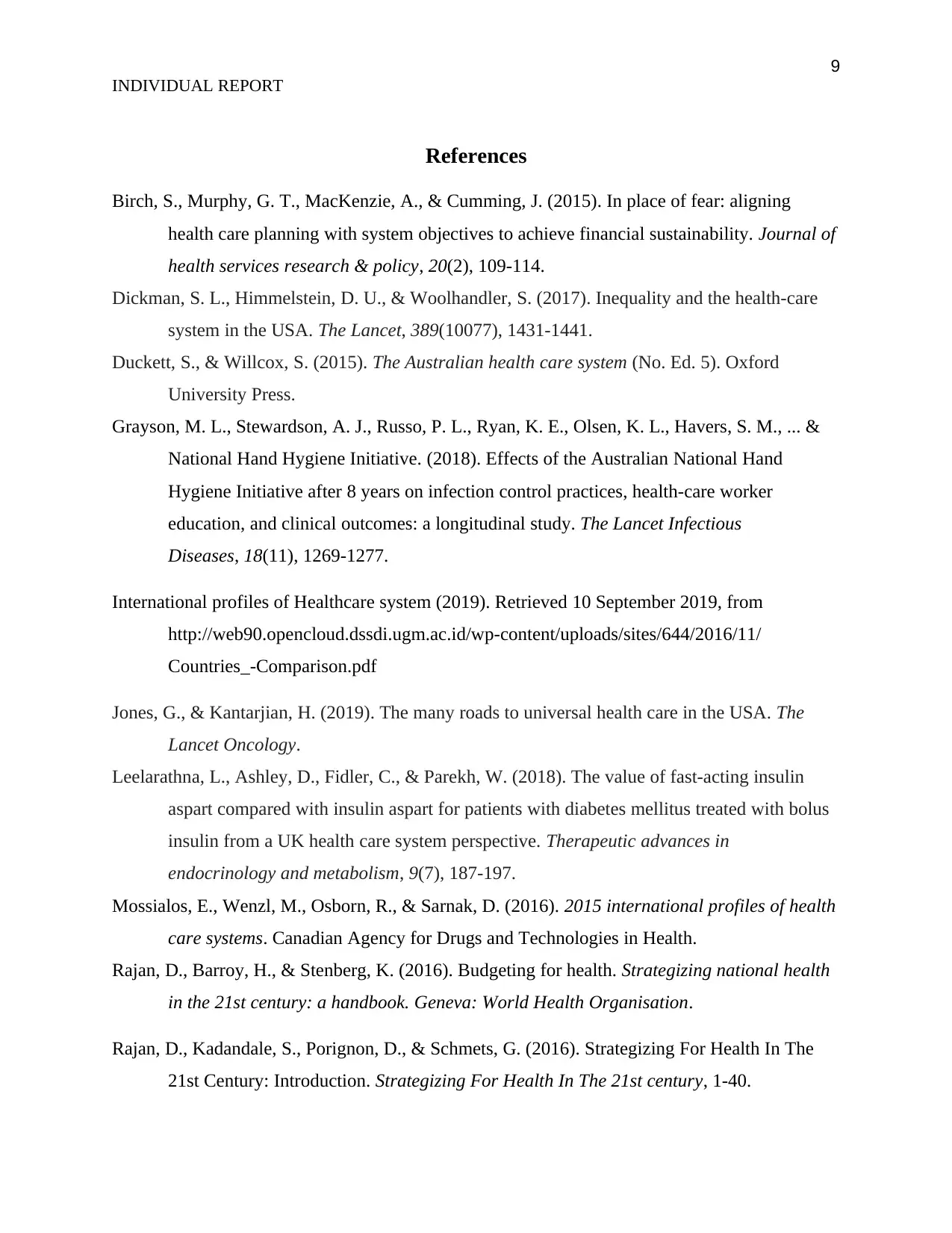
9
INDIVIDUAL REPORT
References
Birch, S., Murphy, G. T., MacKenzie, A., & Cumming, J. (2015). In place of fear: aligning
health care planning with system objectives to achieve financial sustainability. Journal of
health services research & policy, 20(2), 109-114.
Dickman, S. L., Himmelstein, D. U., & Woolhandler, S. (2017). Inequality and the health-care
system in the USA. The Lancet, 389(10077), 1431-1441.
Duckett, S., & Willcox, S. (2015). The Australian health care system (No. Ed. 5). Oxford
University Press.
Grayson, M. L., Stewardson, A. J., Russo, P. L., Ryan, K. E., Olsen, K. L., Havers, S. M., ... &
National Hand Hygiene Initiative. (2018). Effects of the Australian National Hand
Hygiene Initiative after 8 years on infection control practices, health-care worker
education, and clinical outcomes: a longitudinal study. The Lancet Infectious
Diseases, 18(11), 1269-1277.
International profiles of Healthcare system (2019). Retrieved 10 September 2019, from
http://web90.opencloud.dssdi.ugm.ac.id/wp-content/uploads/sites/644/2016/11/
Countries_-Comparison.pdf
Jones, G., & Kantarjian, H. (2019). The many roads to universal health care in the USA. The
Lancet Oncology.
Leelarathna, L., Ashley, D., Fidler, C., & Parekh, W. (2018). The value of fast-acting insulin
aspart compared with insulin aspart for patients with diabetes mellitus treated with bolus
insulin from a UK health care system perspective. Therapeutic advances in
endocrinology and metabolism, 9(7), 187-197.
Mossialos, E., Wenzl, M., Osborn, R., & Sarnak, D. (2016). 2015 international profiles of health
care systems. Canadian Agency for Drugs and Technologies in Health.
Rajan, D., Barroy, H., & Stenberg, K. (2016). Budgeting for health. Strategizing national health
in the 21st century: a handbook. Geneva: World Health Organisation.
Rajan, D., Kadandale, S., Porignon, D., & Schmets, G. (2016). Strategizing For Health In The
21st Century: Introduction. Strategizing For Health In The 21st century, 1-40.
INDIVIDUAL REPORT
References
Birch, S., Murphy, G. T., MacKenzie, A., & Cumming, J. (2015). In place of fear: aligning
health care planning with system objectives to achieve financial sustainability. Journal of
health services research & policy, 20(2), 109-114.
Dickman, S. L., Himmelstein, D. U., & Woolhandler, S. (2017). Inequality and the health-care
system in the USA. The Lancet, 389(10077), 1431-1441.
Duckett, S., & Willcox, S. (2015). The Australian health care system (No. Ed. 5). Oxford
University Press.
Grayson, M. L., Stewardson, A. J., Russo, P. L., Ryan, K. E., Olsen, K. L., Havers, S. M., ... &
National Hand Hygiene Initiative. (2018). Effects of the Australian National Hand
Hygiene Initiative after 8 years on infection control practices, health-care worker
education, and clinical outcomes: a longitudinal study. The Lancet Infectious
Diseases, 18(11), 1269-1277.
International profiles of Healthcare system (2019). Retrieved 10 September 2019, from
http://web90.opencloud.dssdi.ugm.ac.id/wp-content/uploads/sites/644/2016/11/
Countries_-Comparison.pdf
Jones, G., & Kantarjian, H. (2019). The many roads to universal health care in the USA. The
Lancet Oncology.
Leelarathna, L., Ashley, D., Fidler, C., & Parekh, W. (2018). The value of fast-acting insulin
aspart compared with insulin aspart for patients with diabetes mellitus treated with bolus
insulin from a UK health care system perspective. Therapeutic advances in
endocrinology and metabolism, 9(7), 187-197.
Mossialos, E., Wenzl, M., Osborn, R., & Sarnak, D. (2016). 2015 international profiles of health
care systems. Canadian Agency for Drugs and Technologies in Health.
Rajan, D., Barroy, H., & Stenberg, K. (2016). Budgeting for health. Strategizing national health
in the 21st century: a handbook. Geneva: World Health Organisation.
Rajan, D., Kadandale, S., Porignon, D., & Schmets, G. (2016). Strategizing For Health In The
21st Century: Introduction. Strategizing For Health In The 21st century, 1-40.
⊘ This is a preview!⊘
Do you want full access?
Subscribe today to unlock all pages.

Trusted by 1+ million students worldwide
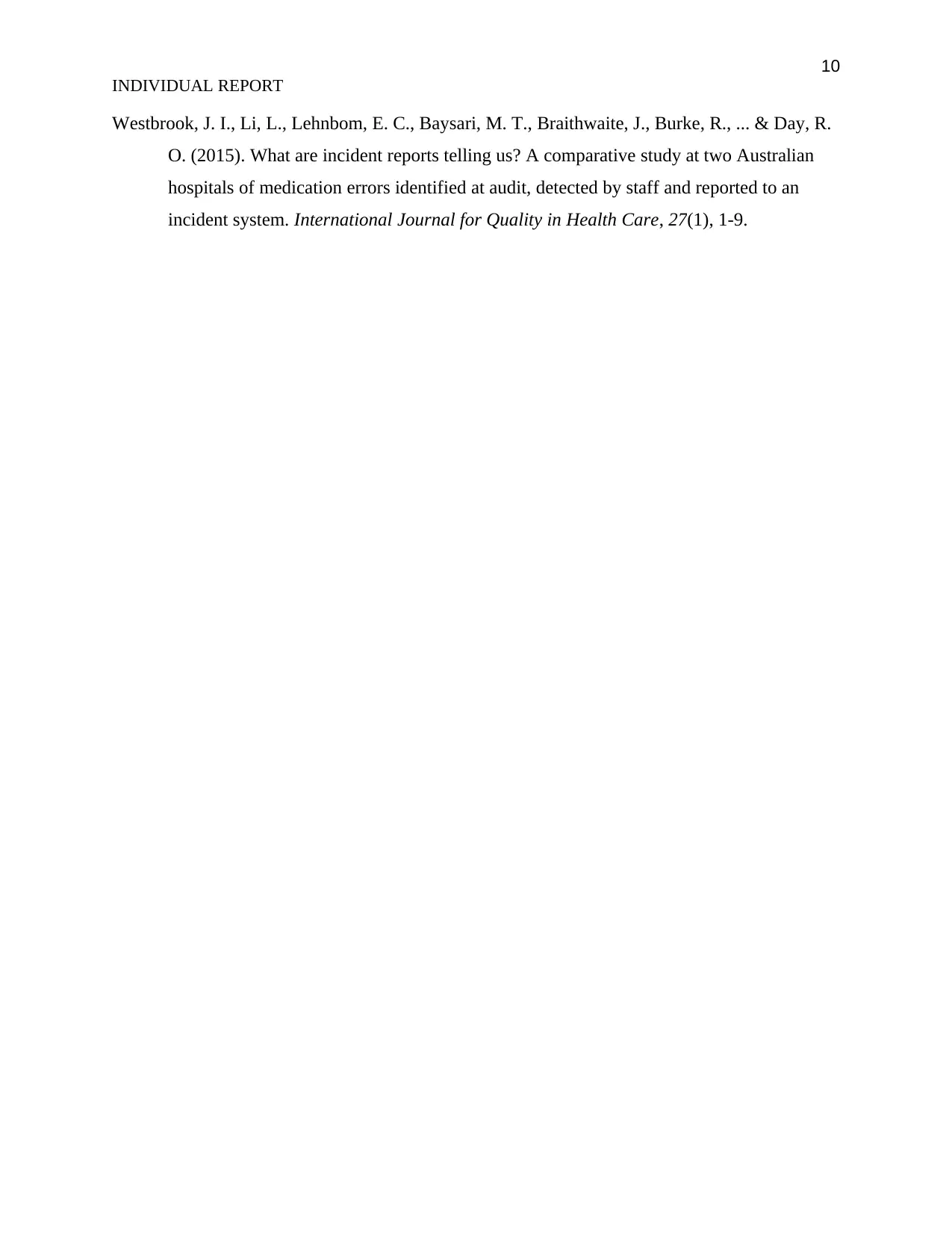
10
INDIVIDUAL REPORT
Westbrook, J. I., Li, L., Lehnbom, E. C., Baysari, M. T., Braithwaite, J., Burke, R., ... & Day, R.
O. (2015). What are incident reports telling us? A comparative study at two Australian
hospitals of medication errors identified at audit, detected by staff and reported to an
incident system. International Journal for Quality in Health Care, 27(1), 1-9.
INDIVIDUAL REPORT
Westbrook, J. I., Li, L., Lehnbom, E. C., Baysari, M. T., Braithwaite, J., Burke, R., ... & Day, R.
O. (2015). What are incident reports telling us? A comparative study at two Australian
hospitals of medication errors identified at audit, detected by staff and reported to an
incident system. International Journal for Quality in Health Care, 27(1), 1-9.
1 out of 10
Related Documents
Your All-in-One AI-Powered Toolkit for Academic Success.
+13062052269
info@desklib.com
Available 24*7 on WhatsApp / Email
![[object Object]](/_next/static/media/star-bottom.7253800d.svg)
Unlock your academic potential
Copyright © 2020–2025 A2Z Services. All Rights Reserved. Developed and managed by ZUCOL.



